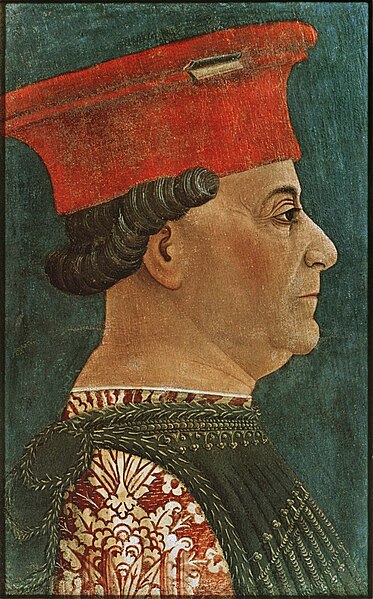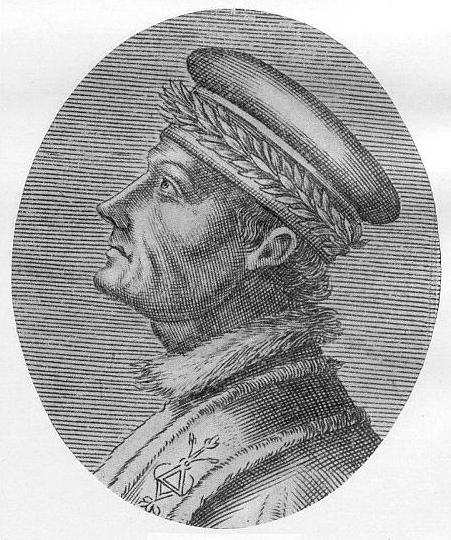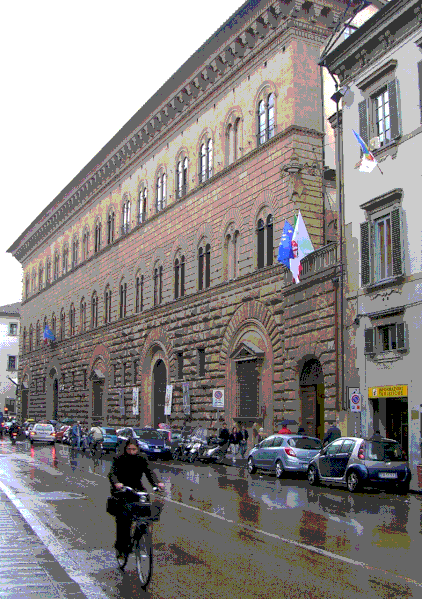 |
| Francesco Sforza |
Capturing a Dukedom
Caterina was born in 1463, the daughter of Galeazzo Maria Sforza, eldest son of Francesco Sforza, Duke of Milan, and his mistress Lucrezia Landriani. Lucrezia had been married off to Count Gian Piero
Landriani, a compliant Milanese courtier and friend of Galeazzo Maria’s.
Caterina was acknowledged by her father and was brought up in the ducal
household.
Francesco
Sforza was the first Sforza duke of Milan; previously he had been a condottierre. His father had been taken into the
service of Filippo Maria Visconti, the then duke. Francesco married
Visconti’s illegitimate daughter Bianca Maria and when her father died Francesco planned
to take over the dukedom. His plan was foiled by the Milanese nobility who
immediately declared the city a republic.
The
fledgling republic faced notable enemies[i], foremost of which was Venice. Francesco was hired to lead Milan’s armies; he swiftly
retook the territories seized by Venice and then turned round and in 1448 did a
deal with Milan’s enemy. Francesco turned his troops round to seize Milan for
himself following a siege of two months duration.
One
of Francesco’s priorities was the rebuilding of Milan’s defences and he rebuilt
the Portia Giovia[ii]. He later had the Maggiore hospital built. Francesco encouraged the
setting up of printing presses and innovation in industry. Then as now, Milan
was also a centre of the fashion industry, where the fashion for dagging[iii] was invented.
Childhood
 |
| Galeazzo Maria Sforza |
When
Caterina was three her grandfather died and Galeazzo Maria became Duke of Milan
and the family took up residence in the Portia Giovia. Galeazzo Maria was a man
of some learning and discernment; he was also a competent ruler, although
arrogant and, according to rumour, given to psychopathic inhumanity towards
others[iv]. For the first few years of his
reign as duke his mother ruled alongside him. He complained that she frequently
treated him;
Caterina
was educated along with her four legitimate half-brothers and sisters; Gian Galeazzo (born 14th June 1469),
Hermes Maria Sforza (born 10th May 1470)[vii], Bianca Maria (born 5th April 1472)[viii] and Anna Maria (born 21st July 1476)[ix]
 |
| Francesco Filefo |
The
children’s tutor was Francesco Filelfo, a noted humanist and the poet of the Milanese court[x]. The children were taught Latin and
perused the works of Seneca, Cicero and Virgil, The ducal library contained over one thousand books. The
religious side of their education was not neglected and the children studied
the lives of the saints. Caterina apparently read Boccaccio’s De Mulieribus Claris[xi].
All
the Sforza children were also taught to fight along with some military strategy,
learning to use weapons as well as riding and how to hunt. Caterina frequently
accompanied her stepmother and her grandmother to the family hunting grounds at
Pavia. An intrepid horsewoman as well as a
beauty Bona treated Caterina as one of her own brood. She may have taught
Caterina much of her own political savvy.
A Trip to Florence
 |
| Mantua |
In March 1471
the eight year old Caterina was one of the family who made a triumphal progress
to Mantua, Ferrara and Florence to celebrate Galeazzo Maria’s
appointment as Duke. The family all had splendid new outfits to bedazzle the
rich and mighty of the territories they would travel to en route to Florence.
Fourteen
carriages, drawn by horses with cloth of gold drapes, carried the family and
courtiers and they had an escort of a hundred knights, five hundred foot
soldiers and fifty grooms, all wearing the Sforza red and white. To entertain
him on the journey Galeazzo Maria travelled with his huntsmen, hounds hawks,
falcons, dwarves, jesters and musicians.
The first
stop was Mantua where the family were the guests of Ludovico Gonzaga[xii], Marquis of Mantua. Gonzaga was an art lover and his
court painter was Andrea Mantegna who was working on the frescoes of
the Camera Picta which was nearly complete. Galeazzo
Maria much admired the work.
 |
| Palazzo Medici |
Upon their
arrival in Florence the family were greeted by Lorenzo de’ Medici who had them stay with him in his palazzo on the Via Larga[xiii].
Lorenzo arranged for one of his favourite artists, Piero del Pollaiolo, to paint Galeazzo Maria. Among
other spectacles the family was taken to see ‘the Ascension of Christ’ at the church of Santa Maria del Carmine. Local children played the parts of
angels who flew through the air on wires.
The simply
dressed Florentines were scandalised by the excesses of Milanese fashion,
feeling that it gave the wrong impression to the city’s younger inhabitants; Machiavelli commented that the Milanese
acerbated the Florentine desire for;
‘Courtly finery and customs
contrary to any well-ordered society, he [Galeazzo Maria] left it even more
so.’[xiv]
The visit
with Lorenzo imbued Galeazzo Maria with respect for his host.
A Brush With Death
 |
| Milan |
Not long
after his return from Florence Galeazzo Maria fell ill with smallpox. Bona, who would become Regent in the event of her husband’s death,
wrote to her brother-in-law Louis XI, the king of France. She asked Louis for his support for
her two year old son Gian Galeazzo’s claim to the dukedom. She also wrote to
Mantua asking for support from the Gonzaga family.
Fortunately
Bona’s precautions were unnecessary as Galeazzo Maria recovered, much to the
surprise of his doctors. This brush with death invigorated him and, possibly
inspired by Lorenzo de’ Medici, set Milan on a new course. Art, architecture
and music were encouraged and flourished and Milan emerged as a rival to
Florence.
The family
chapel became famous and musicians and composers came from as far as the Low Countries and Naples[xv] to perform there. Caterina
benefitted from her father’s decision; she learnt to appreciate art and to
compose and recite Latin poetry.
Galeazzo
Maria was also looking to expand his domains and in 1471 took the town of Imola from the Manfredi family. His plans were not hindered by the
death of Pope Paul II on 26th July 1471[xvi].
In his place Pope
Sixtus IV[xvii] was elected with the connivance of
Galeazzo Maria, a fact of which Sixtus was well aware.
Bibliography
Italian
Dynasties – Edward Burman, Equation 1989
The Deadly
Sisterhood – Leonie Frieda, Harper Collins 2013
The Rise and
Fall of the House of Medici – Christopher Hibbert, Folio Society 2001
Tigress of
Forli – Elizabeth Lev, Head of Zeus Ltd, 2012
The Families
Who Made Rome – Anthony Majanlahti, Pimlico 2006
Absolute
Monarchs – John Julius Norwich, Random House 2011
A
Renaissance Tapestry – Kate Simon, Harrap Ltd 1988
Niccolo’s
Smile – Maurizio Viroli, IB Tauris & Co Ltd 2001
www.wikipedia.en
[i]
Milan was a city of about 200,000, one of the largest in
Europe at the time; it was a thriving commercial hub specialising in the
production of silk and armour where agents from across Europe would merge on
the Via dei Spadari where the foremost armourers, the Missaglia family, had their palazzo.
[ii]
Now known as the Castello Sforzesco
[iii]
Specially cut cloth used as decoration; “created by cutting the edge
of a garment in a regular fashion to prevent it from fraying. This became a
fashion statement as more complex shapes like leaves, tongues and scallops were
introduced as well as a simple triangular cut. It originated in the middle of
the 14th century, perhaps in response to imported fabrics which were harder to
hem, and lasted about 150 years, including on wool and linen garments once it
became a fashion statement not merely a practical response.” Information provided
by the author of http://sarahs-history-place.blogspot.com/
[iv]
His enemies alleged that he raped the wives and daughters of his nobles and
that he received much pleasure devising tortures for those who had aggravated
him. Additionally he was to supervise the torturing of such individuals, even
lending a hand from time to tome
[v]
Tigress of Forli - Lev
[vi]
Bona had been due to become Edward IV’s
affianced bride, until the news of his
marriage to Elizabeth
Woodville became public
[x]
Author of Sforzinda, an epic poem
detailing Francesco Sforza’s deeds which no doubt accounted for his popularity
[xi]
A study of 104 women including Joanna of Jerusalem
who had hired Caterina’s great grandfather Muzio Attendolo as a
bodyguard and lover.
[xii]
The Gonzagas were former condottiere too
[xiii]
The two families were allied; Cosimo de’ Medici
had opened a bank in Milan after Francesco became duke
[xiv]
Tigress of Forli - Lev
[xv]
Galeazzo Maria enticed several of the king’s performers away from Naples to
sing in his choir not long after negotiating an alliance with the king
[xvi]
From a stroke allegedly engendered by his love of comely young men and melons
[xvii]
Former general of the Franciscans
and a distinguished theologian who was to become known for his nepotism (one of
his first actions as pope was to make two of his nephews cardinals) and
spending money like water; his coronation tiara cost about one third of the
annual income of the papacy. See http://wolfgang20.blogspot.co.uk/2015/05/at-court-of-borgia-ii.html
I had no idea that dagging originated in Milan, thank you for that snippet! Florentine fashion was heavily based on a mix of its powerful Arte della Lana, the wool guild, and the import via the vassal town of Pisa of exotic dyes like kermes and grana, both types of beetle, the one vermillion and the other crimson. These permitted the dying of dark, rich colours, which are all known, confusingly, as scarlet. The one flamboyant colour used in Florence is pavanazzo, which is a mix of indigo, orchil and other dyes and in appearence is like the dark purplish blue on a peacock. Sumptuary law in Florence permitted a bride to wear sumptuous garb for a year after she was married, after which it had to be covered at all times by a heavy cloak. Only courtesans flaunted fine fabrics all the time. Which might have been why the Florentines were shocked. Male fashion relied heavily on the sober cioppa or overgown, and the conspicuous consumption was in having a black that was darker and richer than other people's.
ReplyDelete